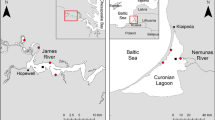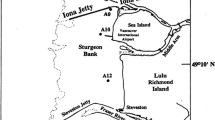Abstract
During two cruises to the Baltic (Mecklenburg Bight) in September 1993 and November 1994 bottom water and sediment samples were taken from 5 stations on a 2.0 km long transect above a benthic sandy silt community. Profiles of total particulate matter, particulate organic carbon, chlorophyll equivalents and urea were taken in the benthic boundary layer (5–40 cm height above sea floor) on the downstream stations across an area occupied by macrofauna feeding at the sediment-water interface at 26 m water depth. Particulate matter concentration profiles varied under the two different flow conditions in September ( u* = 0.7 cm s-1) and November (u* = 0.2 cm s-1). In September 1993 resuspension of total particulate matter (TPM) of 22 to 130 mg m-2 h-1 occurred while particulate organic carbon (POC) and chlorophyll (CPE) were deposited with a rate of 9 mg m-2 h-1 and 0.11 mg m-2 h-1 respectively at the station of highest macrofauna abundance. In November 1994 physical sedimentation and biological deposition of up to 388 mg m-2 h-1 TPM, 7.4 mg m-2 h-1 POC and 0.07 mg m-2 h-1 CPE occurred. Urea was released into the water column. Data suggest that in shallow water environments local sediment and benthic boundary layer characteristics prevent large scale calculations of fluxes of particulate matter.
Similar content being viewed by others
References
Allen, J. R. L., 1971. A theoretical and experimental study of climbing-ripple cross lamination, with a field application to the Uppsoka esker. Geogr. Ann. 53A: 157–187.
Aller, R. & J. Yingst, 1985. Effects of the marine deposit-feeders Herteromastus filiformisPolychaeta, Macoma baltica Bivalvia and Tellina texana Bivalvia on averaged sedimentary solute transport, reaction times and microbial distributions. J. Mar. Res. 433: 615–645.
Asmus, R. M. & H. Asmus, 1991. Mussel beds: limiting or promoting phytoplankton J. exp. mar. Biol. Ecol. 148: 215–232.
Barnett, P. R. O., J. Watson & D. Conelly, 1984. A multiple corer for taking virtually undisturbed samples from, shelf, bathyal and abyssal sediments. Oceanol. Acta 7: 339–409.
Bender, K. & W. R. Davis, 1984. The Effect of Feeding by Yoldia Limatula on Bioturbation. Ophelia 23: 91–100.
Bock M. & D. C. Miller, 1995. Storm effects on particulate food resources on an intertidal sandflat. J. exp. mar. Biol. Ecol. 187: 81–101.
Bodungen, B. V., M. Wunsch & H. Fürderer, 1991. Sampling and analysis of suspended and sinking particles in the North Atlantic. Geophys. Monogr. 63: 47–56.
Dame, R. F., J. D. Spurrier & T. G. olaver, 1989. Carbon, nitrogen and phosphorus processing by an oyster reef. Mar. Ecol. Prog. Ser. 54: 249–256.
Davis, W. R., 1993. The role of bioturbation in sediment resuspension and its interaction with physical shearing. J. exp. mar. Biol. Ecol. 171: 187–200.
Eckman, J. E. & A. R. M. Nowell, 1984. Boundary skin friction and sediment transport about an animal tube mimic. Sedimentology 31: 851–862.
Edler, L., 1979. Recommendation methods for marine biological studies in the Baltic Sea-Phytoplankton and Chlorophyll. BMB Publications 5: 25–31.
Fauchald, K. & P. A. Jumars, 1979. The diet of worms: A study of polychaete feeding guilts. Oceanogr. Mar. Biol. Ann. Rev. 17: 193–284.
Fennel, W. & M. Sturm, 1992. Dynamics of the western Baltic. J. Mar. Syst. 3: 183–205.
Flach, E. & L. Thomsen, 1998. Do physical and chemical factors structure the macrobenthic community at a continental slope in the NE Atlantic. Hydrobiologia 375/376: 265–285.
Gosselck, F., F. Doerschel & T. Doerschel, 1987. Further developments of macrozoobenthos in Lübeck Bay, followimg recolonisation in 1980/81. Int. Rev. Ges. Hydrobiol. 725: 631–638.
Graf, G. & R. Rosenberg, 1997. Bioresuspension and Biodeposition - A Review. J. Mar. Systems 11: 269–278.
Grant, J., 1983. The relative magnitude of biological and physical sediment reworking in an intertidal community. J. Mar. Res. 41: 673–689.
Grasshoff, K., K. Ehrhard & K. Kremling, 1976. Methods of seawater analysis. Verlag Chemie, Weinh. 317 pp.
Gust, G. & G. L. Weatherly, 1985. Velocities, turbulence and skin friction in a deep-sea logarithmic layer. J. Geophys. Res. 90: 4779–4792.
Hily, C., 1991. Is the activity of benthic suspension feeders a factor controlling water quality in the Bay of Brest? Mar. Ecol. Prog. Ser. 69: 179–188.
Jähmlich, S., 1996. Untersuchungen zur Partikeldynamik in der Bodengrenzschicht der Mecklenburger Bucht, GEOMAR Reports, Universität Kiel. 85 pp.
Jumars, P. A. & A. R. M. Nowell, 1984. Effects of benthos on sediment transport: difficulties with functional grouping. Cont. Shelf Res. 3: 115–130.
Jumars, P. A., 1993. Concepts in biological oceanography, Oxford University Press. 348 pp. LaBarbera, M., 1984. Feeding currents and particle capture mechanisms in suspension feeding animals. Am. Zool. 24: 71–84.
Levinton, J. S., 1991. Variable feeding behaviour in three species of Macoma as a response to water flow and sediment transport. Mar. Biol. 110: 375–383.
Loo, L.-O. & R. Rosenberg, 1989. Bivalve suspension feeding dynamics and benthic-pelagic coupling in an eutrophicated marine bay. J. exp. mar. Biol. Ecol. 130: 253–276.
Mann, K. & J. Lazier, 1991. Dynamics of marine ecosystems. Blackwell Scientific Publications. 306 pp.
Michaelis, H., 1978. Zur Morphologie und Ökologie von Polydora cilliata und P. Ligni Polychaete, Spionodae. Helg. Wiss. Unters. 31: 102–116.
Middleton, G. V. & J. B. Southard, 1984. Mechanics of sediment movement. S.E.P.M. Short course Number 3, 2nd Edition, Tulsa, USA.
Miller, D. C., P. A. Jumars & A. R. M. Nowell, 1984. Effects of sediment transport on deposit feeding: scaling arguments. Limn. Oceanogr. 29: 1202–1217.
Miller, D. C. & P. A. Jumars, 1986. Pellet accumulation sediment supply and crowding as determinants of surface deposit-feeding rate in Pseudopolydora kempi japonica. J. exp. mar. Biol. Ecol. 99: 1–17.
Miller, D. C. & R. W. Sternberg, 1988. Field measurements of the fluid and sediment-dynamic environment of a benthic deposit feeder. J. Mar. Res. 46: 771–796.
Miller, D. C., M. J. Bock & E. J. Turner, 1992. Deposit and suspension feeding in oscillary flows and sediment fluxes. J. Mar. Res. 50: 489–520.
Muschenheim, D. K. & C. R. Newell, 1992. Utilization of seston over a mussel bed. Mar. Ecol. Prog. Ser. 85: 131–136.
Nowell, A. R. M. & P. A. Jumars, 1987. Flumes: theoretical and experimental considerations for simulation of benthic environments. Oceanogr. Mar. Bio. Ann. Rev. 25: 91–112.
Nowell, A. R. M., P. A. Jumars, R. L. Self & J. B. Southard, 1989. The effects of sediment transport and deposition on infauna: results obtained in a specifically designed flume. In S. R. Lopez, G. Taghon & J. Levinton (eds), Ecology of Marine Deposit Feeders. Springer Verlag: 215–228.
Officer, C. B, T. J. Smayda & R. Mann, 1982. Benthic filter feeding: a natural eutrophication control. Mar. Ecol. Prog. Ser. 2: 203–210.
Rowden, A. A. & M. B. Jones, 1994. A contribution to the biology of the burrowing mud shrimp, Callianasssa subteranea. J.Mar. Biol Assoc. U.K. 74: 623–635.
Rumohr, H., 1993. Erfahrungen und Ergebnisse aus 7 Jahren Benthosmonitoring in der südlichen Ostsee. In P. DF. J. Duinker (ed.), Das biologische Monitoring der Ostsee im Insitut für Meereskunde Kiel, 1985-1992. IFM Report, 240, Inst. F. Meereskunde, Kiel.
Rumohr, H., 1993. Monitoring the marine environment with imaging methods. Sci. Mar. 95: 129–138.
Sternberg, R. W., R. V. Johnson, D. A. Cacchione & D. E. Drake, 1986. An instrument system for monitoring and sampling suspended sediment in the benthic boundary layer. Mar. Geol. 71: 187–199.
Thagon, G. L. & R. R. Greene, 1992. Utilisation of deposited and suspended particulate matter by benthic interface feeders. Limnol. Oceanogr. 67: 1370–1391.
Thomsen, L., G. Graf, V. Martens & E. Steen, 1994. An instrument for sampling water from the benthic boundary layer. Cont. Shelf Res. 14: 871–882.
Thomsen, L., G. Graf, K. V. Juterzenka & U. Witte, 1995. An in situ experiment to investigate the depletion of seston above a suspension feeder field on the continental slope of the western Barents Sea. Mar. Ecol. Prog. Ser. 123: 295–300.
Thomsen, L., S. Jähmlich, G. Graf, M. Friedrichs, B. Springer & S. Wanner, 1996. An instrument for aggregate studies in the benthic boundary layer. Mar. Geol. 135: 153–157.
Thomsen, L. & E. Flach, 1997. Mesocosm observations of fluxes of particulate matter within the benthic boundary layer. J. Sea Res. 37: 67–79.
Thomsen, L. & T. C. v. Weering, 1998. Spatial and temporal variability of particulate matter in the benthic boundary layer at the North East Atlantic Continental Margin (Goban Spur). Prog. Oceanogr. (in press)
Turley, C., 1980. Distribution and biodegradation of urea in coastal waters. Dissertation, University of Wales.
Vedel, A., B. B. Andersen & T. Riisgå rd, 1994. Field investigations of pumping activity of the facultativ filter-feeding polychaete Nereis diversicolorusing an improved infrared phototransducer system. Mar. Ecol. Progr. Ser. 103: 91–101.
Zettler, M. L. & A. Bick, 1996. The analysis of small-andmesoscale dispersion pattern of Marenzelleria viridisPolychaeta: Spionidae in acoastal water of the southern Baltic. Helgol. Meeresunters. 502: 265–286.
Rights and permissions
About this article
Cite this article
Thomsen, L., Jähmlich, S. An in situ experiment to investigate the modification of particulate matter and urea above a benthic sandy silt community in the Baltic Sea. Hydrobiologia 375, 353–361 (1998). https://doi.org/10.1023/A:1017019932033
Issue Date:
DOI: https://doi.org/10.1023/A:1017019932033




